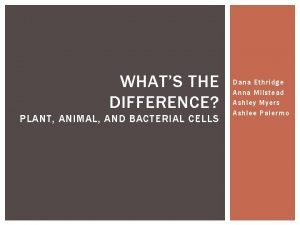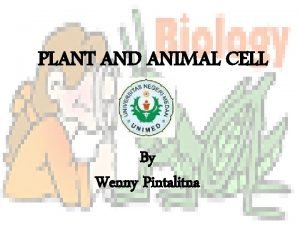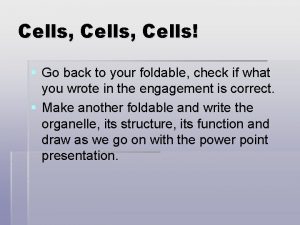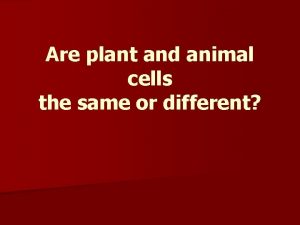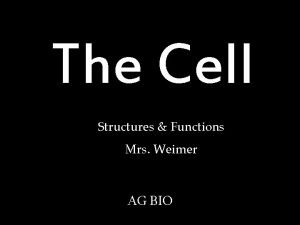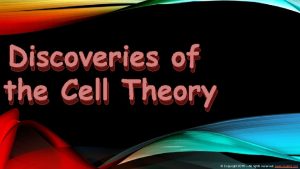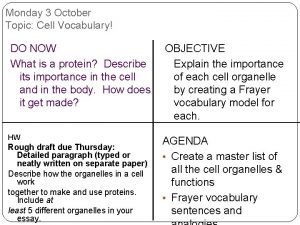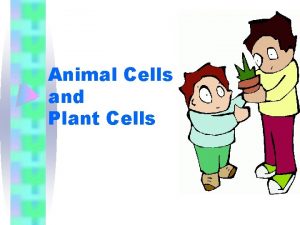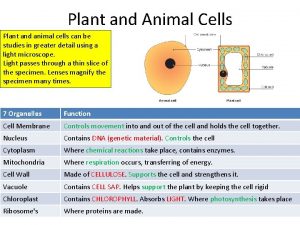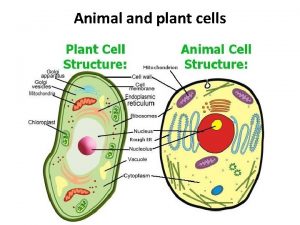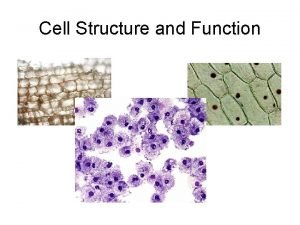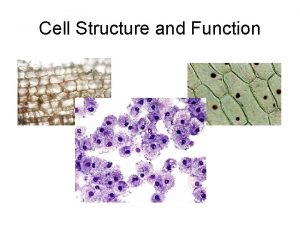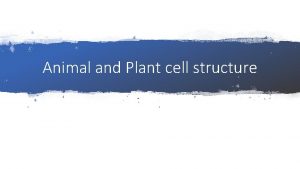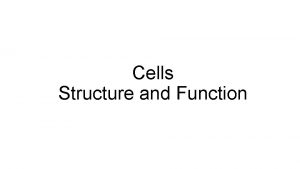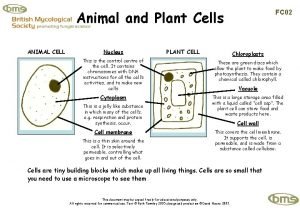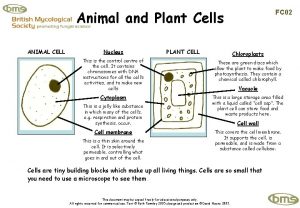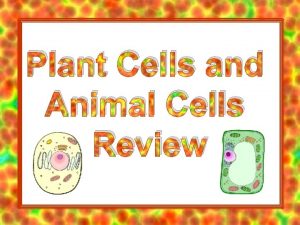Cells their structure and function Animal Cell Plant



















- Slides: 19

Cells – their structure and function Animal Cell Plant Cell

How did we discover cells? • Anton van Leeuwenhoek created the first microscope using a single lens • Robert Hooke used one of the first microscopes to look at thin pieces of cork (plant) and found tiny chambers which he called “cells” Discoveries of these scientists and others led to the Cell Theory (text p. 170 -171)

Cell Theory • All living things are composed of cells • Cells are the basic units of structure and function in living things • New cells are produced from existing cells Cells can be divided into 2 types: eukaryotes and prokaryotes.

Basic Cell Structures Cell membrane – thin, flexible barrier around the cell Cell wall – strong layer around cell membrane in plant cells Nucleus – contains cell’s genetic material and directs the synthesis of proteins that control the cell’s activities Cytoplasm – jellylike substance inside the cell that contains specialized structures, transports materials throughout the cell and is the site of many chemical reactions

Cell Membrane Cytoplasm

Some cells have a cytoskeleton which is a network of protein filaments that helps the cell keep its shape. It also helps with cell movement.

Eukaryotic cells contain organelles that are specialized to perform specific jobs in the cell. Ribosomes – made of RNA and protein and produce proteins from instructions sent by the nucleus Endoplasmic Reticulum – makes parts of the cell membrane and modifies some proteins Golgi apparatus – attaches carbohydrates and lipids to proteins using enzymes Ribosome

Vacuoles – saclike structures that store water, salts, proteins and carbohydrates Chloroplasts – site of photosynthesis, found in plant cells, contain DNA Mitochondria – site of cellular respiration, make ATP energy from glucose molecules, contain DNA (inherited from your mother)

Chloroplast

Comparison of Cells Structure Cell membrane Cell wall Nucleus Ribosomes Endoplasmic reticulum Golgi apparatus Lysosomes Vacuoles Mitochondria Chloroplasts Cytoskeleton Prokaryotic cells Eukaryotic Animal Cell Eukaryotic Plant Cell

Transport Through the Cell Membrane

Diffusion – movement of materials from areas of high concentration to areas of low concentration, does not require energy

Osmosis – diffusion of water through a selectively permeable membrane

Facilitated diffusion – movement of molecules from areas of high concentration to areas of low concentration through protein channels

Isotonic, Hypertonic Solutions

Active Transport – movement of material from an area of low concentration to an area of high concentration; requires ATP energy

Sometimes a cell is an organism. Examples are bacteria, yeast, and protozoa.

Multicellular organisms have specialized cells that perform particular functions in the organism. Nerve cell Skeletal Muscle

Levels of organization in a multicellular organism are individual cells, tissues, organs, and organ systems.
 What is an organelle
What is an organelle Venn diagram of plant and animal cells
Venn diagram of plant and animal cells Plant cell and animal cell diagram
Plant cell and animal cell diagram What is the main function of a vacuole
What is the main function of a vacuole Idealized animal cell
Idealized animal cell Flexible covering of an animal cell
Flexible covering of an animal cell Function of the cell wall
Function of the cell wall Whats the difference between animal and plant cells
Whats the difference between animal and plant cells Prokaryotic and eukaryotic venn diagram
Prokaryotic and eukaryotic venn diagram Perixomes
Perixomes How animal cells use nutrients
How animal cells use nutrients Plant and animal cells
Plant and animal cells Plant and animal cells foldable
Plant and animal cells foldable Whats the difference between plant and animal cells
Whats the difference between plant and animal cells Plant and animal cells
Plant and animal cells Whats the difference between plant and animal cells
Whats the difference between plant and animal cells Cpalms investigating plant and animal cells
Cpalms investigating plant and animal cells Chapter 7-1 life is cellular answer key
Chapter 7-1 life is cellular answer key Plant vs animal cells
Plant vs animal cells Animal cell structure under electron microscope
Animal cell structure under electron microscope







